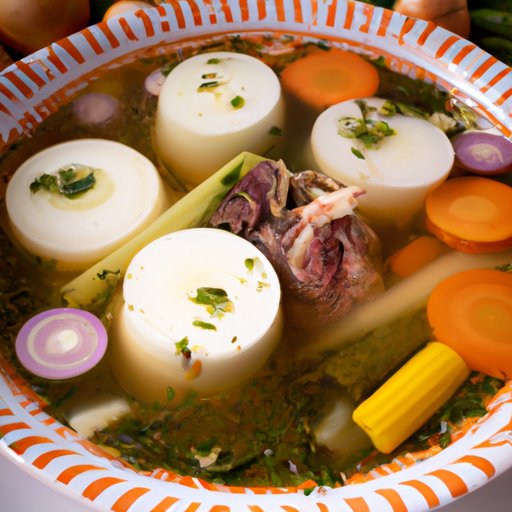Introduction
Caldo de res is a Mexican beef broth soup that is a staple in many traditional Mexican households. It’s a hearty and flavorful dish that is often served with a variety of toppings and accompaniments. While it has been enjoyed for generations, there is still some debate about its nutritional value and health benefits. In this article, we will explore the health benefits and risks of eating caldo de res.

Exploring the Health Benefits of Caldo de Res
Caldo de res is a nutrient-dense soup that is packed with vitamins and minerals. It contains a high amount of protein, which helps to keep you feeling full for longer. Additionally, it is low in calories and fat, making it an ideal choice for those trying to watch their weight. The soup is also rich in iron, calcium, and other essential nutrients.
When comparing caldo de res to other soups, it is important to consider the ingredients used. Many canned or pre-packaged soups contain added sugars and preservatives, which can increase the calorie count and decrease the nutritional value. However, caldo de res is made with natural ingredients, such as beef, vegetables, and spices, so it is a healthier option than some of the more processed varieties.
The Role of Caldo de Res in Traditional Mexican Cuisine
Caldo de res has been a part of traditional Mexican cuisine for centuries. It originated in the state of Jalisco and is now popular throughout Mexico and parts of the United States. It is often served as a comforting meal during the cold winter months and is a favorite of both children and adults alike.
Caldo de res is usually prepared with beef, potatoes, carrots, and onions. Other variations may include chiles, garlic, tomatoes, and seasonings such as oregano and cumin. The soup is typically topped with lime, cilantro, and avocado and is often served with tortillas, rice, and beans.

How to Cook Caldo de Res for Maximum Nutrition
Cooking caldo de res is relatively simple and requires minimal effort. To make the soup, start by browning the beef in a large pot over medium heat. Once the beef is cooked, add the vegetables, seasonings, and stock. Simmer for about 30 minutes, stirring occasionally, until the vegetables are tender. Once the soup is finished, you can garnish with fresh cilantro, lime, and avocado.
It is important to note that caldo de res should be cooked with lean cuts of beef to minimize the fat content. If you are looking for a vegetarian version of the soup, you can substitute the beef for mushrooms or other plant-based proteins.

Examining the Health Risks of Eating Caldo de Res
While caldo de res can be a healthy meal option, there are some potential health risks that should be noted. One of the main concerns is the fat content of the soup. Depending on the type of beef used, the soup can contain up to 20 grams of saturated fat per serving. It is important to opt for leaner cuts of beef to reduce the fat content.
Another potential concern is the sodium levels in caldo de res. The soup can contain up to 500 milligrams of sodium per serving, which is more than twice the recommended daily intake. To reduce the sodium levels, use a low-sodium beef broth or opt for fresh ingredients instead of canned or pre-packaged ones.
Finally, it is important to note that caldo de res contains common allergens, such as wheat and dairy. If you have an allergy to any of these ingredients, it is important to avoid caldo de res or consult your doctor before consuming it.
Conclusion
Caldo de res is a traditional Mexican soup that has been enjoyed for generations. It is a nutrient-dense soup that is packed with vitamins and minerals and can be a healthy meal option when prepared with lean cuts of beef and fresh ingredients. However, it is important to note that caldo de res can be high in fat and sodium and contains common allergens, so it should be consumed in moderation.
(Note: Is this article not meeting your expectations? Do you have knowledge or insights to share? Unlock new opportunities and expand your reach by joining our authors team. Click Registration to join us and share your expertise with our readers.)
